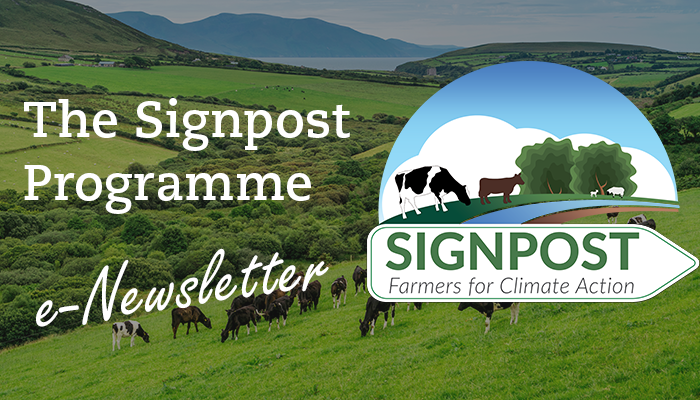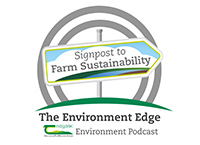06 November 2021
Teagasc Signpost Programme Newsletter November 2021

This months newsletter provides a guide to the actions beef farmers can take to reduce emissions on their farm, including 2 Signpost Farmers, Alex McCarthy (Dairy) & John Barry (Beef), outlining their carbon footprint; A guide & link to the Dairy Energy Decision Support Tool; research update & more
Issue 6 – November 2021
We also have the results of some interesting work from Johnstown Castle on the emissions from compound fertilisers. There is an update from the Signpost programme as well as a guide to housing animals this Autumn to minimise the impact on water quality. Pippa Hackett is interviewed by the Environment Edge Team on the challenges ahead.
Key mitigation actions to reduce greenhouse gas emissions on beef farms
This month’s article provides a guide to the key mitigation actions beef farmers can take to reduce emissions
Climate Actions for November
Each month, we will present climate actions that farmers can take to reduce gaseous emissions. These actions will be practical and timely. See below climate actions for the month of November
Signpost Farmers use their carbon footprint to make a plan
This month we meet 2 farmers, Alex McCarthy (Dairy) and John Barry (Beef) that are engaging with their carbon footprint figure from the Bord Bia Farmer Feedback Report and provide us with some insight into the actions they are taking to reduce emissions.
Click here to watch Alex’s video
Click here to watch John’s video

Solar Panels
Teagasc has partnered with MTU and SEAI to develop the Dairy Energy Decision Support Tool to aide farmers in making decisions regarding energy efficiency and renewable energy investments. This on-line tool can be used to obtain farm specific recommendations related to energy use, technology investments, CO2 mitigation and renewable energy generation.
The tool, known as the Dairy Energy Decision Support Tool (DEDST) is available to use for free
The DEDST can be used to obtain farm specific recommendations related to energy use, technology investments, CO2 mitigation and renewable energy generation. It is an interactive and easy to use tool aimed at farmers, farm managers and farm advisors. It provides information to the user regarding key decisions that determine the energy efficiency and cost effectiveness of the milk production process, such as investment in certain technologies and changes in farm management practices. It can also be used to support government bodies in forming new policy relating to provision of grant aid for energy efficient and renewable energy technologies.
Meet two of the Signpost Farmers

Article on Water Quality
Housing of livestock
Livestock housed over the winter period need facilities that are fit for purpose and have adequate storage capacity for the statutory number of weeks. Farmers should ensure that their housing facilities are designed and used in a manner that minimises the potential impact on water quality.
Research Updates
Ammonium-Based Compound Fertilisers Mitigate
Nitrous Oxide Emissions in Temperate Grassland
Nitrogen fertiliser application represents the largest anthropogenic source of nitrous oxide (N2O) emissions, and the magnitude of these emissions is dependent on the type of fertilisers applied in the agroecosystems. Despite N-P-K compound fertilisers being commonly used in agricultural soils, a lack of information exists regarding their effects on N2O emissions. This study aims at examining the effects of different commonly used N-P-K compound fertiliser formulations with contrasting nitrate to ammonium ratios (0.05 to 0.88) on N2O emissions, yield, and nitrogen use efficiency (NUE) in temperate grassland and to compare these variables with common straight N fertilisers.
Compound fertilisers with varying NPK inclusion rates (18-6-12, 10-10-20, 24-2.2-4.5, and 27-2.5-5), and CAN and protected urea (NBPT) were applied at 80 kg N / ha to experimental plots in managed grassland on two occasions in a growing season. Fluxes of N2O during the experiment period, yield and NUE following two harvests were measured.
The cumulative N2O emission from urea + NBPT, 18-6-12, 10-10-20, and 24-2.2-4.5 treatments were significantly reduced by 44%, 43%, 37%, and 31% compared with CAN treatment under conducive soil moisture condition.

The results suggest that ammonium-based compound fertilisers have a potential to reduce N2O emissions while maintaining yields.
Further long-term study is needed to capture the full magnitude of variations in N2O emissions, including ammonia (NH3 ) volatilization from nitrate and ammonium-based compound fertiliser applications from multiple soil types and under different climatic conditions.
Signpost Programme Update
With the help of their joint programme, local and ASSAP advisers the signpost farmers are currently completing their farm sustainability plans. The farm sustainability plans will assess all environmental areas on the signpost farms, namely gaseous emissions, water quality and biodiversity.
The initial gaseous emissions assessments are tailored to assess the farms on their current performance, short term goals and long term goals around farm actions that will have a positive impact in reducing total farm gaseous emissions. Areas such as fertiliser type used, soil fertility, slurry timing and spreading methods, animal breeding strategy, animal health strategy, age of slaughter, cover crops, flock performance and energy saving are all assessed on the farms. The planner uses a traffic light colour coded system to highlight deficiencies, areas for improvement and areas of best practice. The purpose of the traffic light system is to guide the signpost farmers towards best practice in reducing total farm emissions.

Once the sustainability planner is completed each signpost farmers will receive a report highlighting the areas for action to undertake to reduce farm emissions. The farms will be assessed also for water quality and biodiversity and areas for actions to maintain and improve water quality and biodiversity will be compiled for each farmer.
The Environment Edge Podcast
 The Environment Edge is Teagasc’s environment podcast focusing on challenges and opportunities in agriculture. Presented by Cathal Somers and Deirdre Glynn, this podcast will bring you the latest information, science and opinion on farm sustainability. This week Deirdre and Cathal interview Senator Pippa Hackett on the challenges ahead
The Environment Edge is Teagasc’s environment podcast focusing on challenges and opportunities in agriculture. Presented by Cathal Somers and Deirdre Glynn, this podcast will bring you the latest information, science and opinion on farm sustainability. This week Deirdre and Cathal interview Senator Pippa Hackett on the challenges ahead
Signpost Programme Partners
The Signpost Programme is a collaborative partnership of farmers, industry and State Agencies, working together for climate action.
A friend or colleague can subscribe to this e-newsletter by clicking the subscribe button below
The Teagasc Signpost Programme e-Newsletter will issue monthly and you can read it here each month on on Teagasc Daily.


